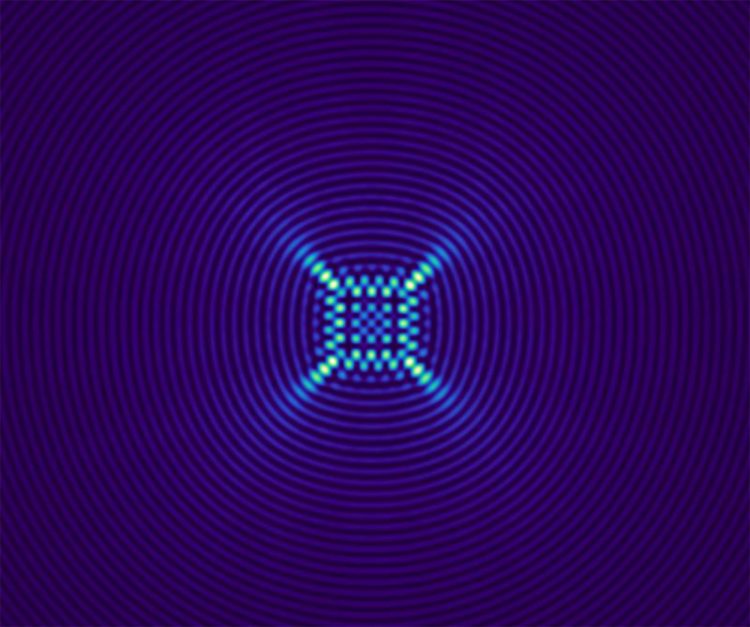Tailored light inspired by nature

This photo shows the fabrication procedure of a nondiffracting of a lightfield using a desired transversed caustic. WWU - Alessandro Zannotti
Modern applications as high resolution microsopy or micro- or nanoscale material processing require customized laser beams that do not change during propagation.
This represents an immense challenge since light typically broadens during propagation, a phenomenon known as diffraction. So-called propagation-invariant or non-diffracting light fields therefore do not seem possible at first glance.
If it were possible to produce them, they would enable new applications such as light disk microscopy or laser-based cutting, milling or drilling with high aspect ratios.
An international research team from the Universities of Birmingham, Marseille and Münster has now succeeded for the first time to create arbitrary nondiffracting beams.
“We implement an approach inspired by nature, in which any desired intensity structure can be specified by its boundaries,” explains one of the authors of the study, Prof. Cornelia Denz from the Institute of Applied Physics at the University of Münster.
The authors cleverly exploit light structures that can be seen in rainbows or when light is transmitted through drinking glasses: spectacular ray structures named caustics. They are bright focus lines that overlap, and thereby building networks that can be exploited for nondiffracting propagation.
The team developed a method to use these caustics as a basis for the generation of arbitrary structures, and has thus created an intelligent manipulation of ray propagation.
In this way, countless new types of laser beams can be formed on the micrometer scale, opening up completely new perspectives in optical materials processing, multidimensional signal transmission or advanced high resolution imaging.
Only some years ago it was possible to realize a few light fields that exhibit these non-diffracting properties, even though the theoretical idea is older: Concentric ring structures like the Bessel beam could be produced in a propagation-invariant way.
The theory predicts a whole class of beams whose transverse shape is generated on elliptical or parabolic trajectories and represent natural solutions of the wave equation.
Although there has long been a need for such customized light beams with these properties, they have hardly been produced experimentally because the invariance of the transverse intensity structure must be maintained during propagation.
The study results of the team were recently published in the journal “Nature Communications”.
Funding:
The study received financial support from the National Science Foundation, the Excellence Initiative of the University of Aix-Marseille and the Universities of Bristol, Birmingham and Münster.
Westfälische Wilhelms-Universität Münster
Institute of Applied Physics
Prof. Cornelia Denz
Tel. 0251 / 83-335-17 (directly)
Tel. 0251 / 83-335-18 (Secretariat)
E-mail: denz@uni-muenster.de
A. Zannotti, C. Denz, M. A. Alonso, M. R. Dennis (2020): Shaping caustics into propagation invariant light. Nature Communications; DOI: 10.1038/s41467-020-17439-3
https://www.nature.com/articles/s41467-020-17439-3 Original publication in “Nature Communications”
https://www.uni-muenster.de/Physik.AP/Denz/en/NLP.html Research group Prof. Cornelia Denz at Münster University
https://markrdennis.com/ Research group of Prof. Mark Dennis, University of Birmingham
https://www.fresnel.fr/spip/spip.php?rubrique424&act=alonso&lang=fr Research group of Prof. Miguel Alonso, University of Aix-Marseille
Media Contact
All latest news from the category: Physics and Astronomy
This area deals with the fundamental laws and building blocks of nature and how they interact, the properties and the behavior of matter, and research into space and time and their structures.
innovations-report provides in-depth reports and articles on subjects such as astrophysics, laser technologies, nuclear, quantum, particle and solid-state physics, nanotechnologies, planetary research and findings (Mars, Venus) and developments related to the Hubble Telescope.
Newest articles

First-of-its-kind study uses remote sensing to monitor plastic debris in rivers and lakes
Remote sensing creates a cost-effective solution to monitoring plastic pollution. A first-of-its-kind study from researchers at the University of Minnesota Twin Cities shows how remote sensing can help monitor and…

Laser-based artificial neuron mimics nerve cell functions at lightning speed
With a processing speed a billion times faster than nature, chip-based laser neuron could help advance AI tasks such as pattern recognition and sequence prediction. Researchers have developed a laser-based…

Optimising the processing of plastic waste
Just one look in the yellow bin reveals a colourful jumble of different types of plastic. However, the purer and more uniform plastic waste is, the easier it is to…


